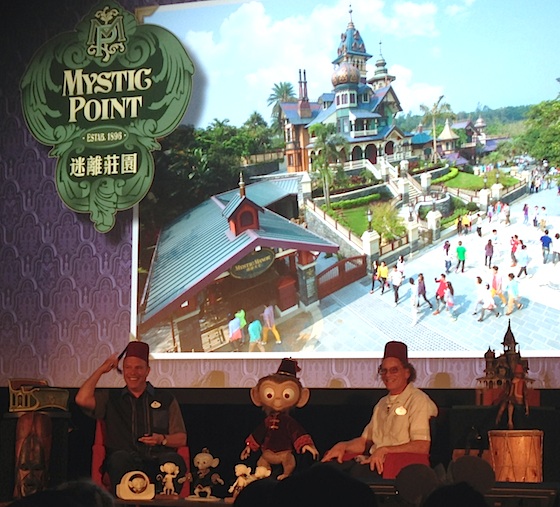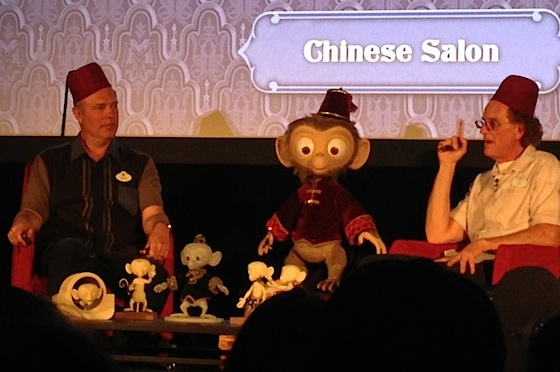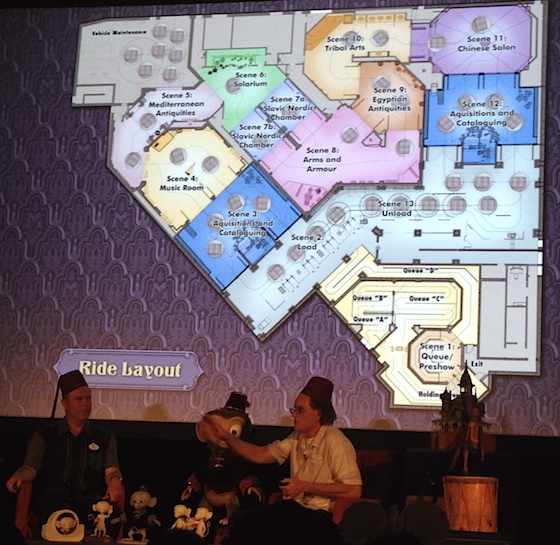This morning at the biennial Disney D23 Expo, Imagineers Joe Lanzisero and Mark Schirmer spoke about their work on Mystic Manor, a "redemption story," as Mark described it, of a beloved sidekick who messes up by opening an enchanted [Pandora's?] music box and then struggles to close it before anything else goes horribly (and hilariously) wrong. Joe and Mark described the project, the challenge of creating a new intellectual property from scratch, and the opportunities afforded by telling their story using a revolutionary new ride system.

Here's an edited transcript of their remarks:
On creating an original story
Joe Lanzisero: "This has probably been a high point of my career, for a bunch of reasons. One, we got to create something totally new. We didn't have to do a Pixar project or something based on something else. [Laughter from audience] It's great that we have all that wonderful IP that we can go to mine for a project, like Monsters Inc. in Tokyo, which Mark and I did together, but this was an opportunity, like the original Imagineers had, to create something totally new -- we created new characters, and new ride system."

"It has its genesis in some pre-existing Disney mythology. Those of you who have been to The Adventurers' Club [loud applause], thank you Joe Rohde for that concept; we took that same idea to Tokyo when I was doing the Tower of Terror there. They didn't know the whole Rod Sterling "Twilight Zone" thing, so we had to create a new story there. And we created this story about this Society of [Explorers and Adventurers] and Harrison Hightower, who owned the hotel there. He was a member of the society, well, surprisingly enough there was another member of the Society, Lord Henry Mystic, who, unlike some of the other characters in the Society -- some of them had kind of shady backgrounds -- Lord Henry here, he's an earnest guy. He's part of the British upper class, traveling the world, and along the way met this little monkey character [the sidekick, Albert]."
The two then played the Mystic Manor preshow for the audience:
Mark Schirmer: "With that preshow, the things we wanted to communicate in there were pretty straightforward: to introduce Albert and certainly Lord Henry, as he's voicing that over, and it was [also] about the music box -- the latest acquisition [in Lord Henry's collection]. It might have some interesting who-knows-what inside and we just need to be careful about it. We really wanted to communicate about those things."
Joe: "When we base an attraction on a movie, our guests come pre-wired with some emotional connection to the experience. They've seen the movie. They have the music from the movie. They know the characters from the movie. It's all in their head. So our job becomes planning those trigger moments. On a Winnie-the-Pooh ride, you're going to want to see Tigger bouncing around and hear the Tigger song. We just have to show that, and boom, that triggers in people's heads this emotional connection. We were starting here with a blank sheet of paper, so it became important for us to start establishing who these characters were and how they got to know each other. So besides that pre-show film, as you walk through the queue line, it's like a museum in his house. It's Lord Henry showing photos of his travels and the other members of the Society. But we also set up how Lord Henry first met Albert. He chose to rescue Albert, and it really creates this bond. They love each other. It's really a father and son-like relationship."
On the ride system
Mark: "One of the things that was really integral to this attraction was the ride system, and the ride vehicle. You may note that it is a trackless system. We actually have more than 200 RFID tags buried in the concrete floor to help guide this system. We start out by dispatching four vehicles at a time, but to help heighten the excitement we actually go down to single file, and then we'll group you back together at the end. We really wanted to help tell the story of this in the queue, where [we say] Lord Henry actually invented this. He was a bit of tinker as well as an explorer. He invented the Magneto-Electric Carriage [the ride vehicle] that he took to the Paris Exhibition of 1900 and of course won the gold medal."
Joe: "In our attractions, ride vehicle usually take on two roles. One, they're invisible, like on Haunted Mansion, with the Doom Buggies. They're really not part of the story. It's just a conveyance device that moves you through the house. In other attractions, Indiana Jones being a good example, or here, the ride vehicle is really part of the storytelling."
"It has the ability to start and stop, turn 360 degrees, go fast, go slow. It really becomes our camera in that we can tell people what we want them to look at. A lot of this is what Walt was really trying to do with the original Haunted Mansion, and that was to create a large-scale magic show. We have some of the most amazing special effects in this show, and the reason why we can pull them off -- most of them have a set-up, they play out and we move on to the next one -- is because we have the ability now with this ride vehicle to time out the whole experience to allow each scene to play through before moving on, unlike rides like Pirates or the Haunted Mansion, which have to be continuous -- it's just a cycle of things that go and go and go, and hopefully you catch the right moment. Here we are guaranteed always to get you at the right moment where we want to to see the particular thing."
On the importance of music and special effects
"Two really, really important things made this show special, and were so key to the storytelling. [One] was the music. We knew from the start that music would be an important part of this, going back to our heritage with great attractions such as It's Small World, Pirates and Haunted Mansion. I bet as I said those names, those songs popped into your head. That's great, because it become part of the experience. So we knew we wanted to have great music. And then this "music dust" [which escapes from the open music box] was so important. It almost becomes a character in how it has to comes alive and brings objects to life and such. So the fact that we were able to get Danny Elfman to do the music, and then to really kind of crack the code on a new special effect that had never been done, this music dust, were pivotal moments in making this happen."
Mark noted that they were able to recruit Elfman because his manager had been at Mark and Jim's initial session previewing Mystic Manor, at the original D23 Expo in 2009, and brought the Mystic Manor project to Elfman as a result.
The two also noted that Mystic Manor includes several homages to other Disney attractions, including an appearance by Trader Sam from the Jungle Cruise, singing busts much like those in the Haunted Mansion, and a Tiki God on a much larger scale than its fellow deities from the Enchanted Tiki Room. The ride also includes a scene with 4D effects, as bugs crawl from a mummy's sarcophagus and into your ride vehicle. (Hey, isn't that an homage to a Universal attraction, too?)
Speaking of Universal...
Joe: "We used a lot of projection in this show, but our goal from the start was that you would never know there was projection. You're not fooling anybody when you can tell there's a screen with something projected on it. There are whole rides that other companies have done where you put on 3D glasses, and it's all projected. I mean, they're cool, but it's not real. I think what makes this ride so much more believable is that you don't have 3D glasses on, everything is dimensional and real. It's all environmental. Wherever there was any kind of projection special effect, we worked very hard to combine things -- there's projection, there's fog effects, there's black light effects, there's animation effects -- everywhere we could to blend things in such a way that the whole is greater than the sum of the parts, and it became one believable thing."

On character animation
"Originally, Lord Henry and Albert were going to be a lot more realistic looking. I have a background in animation, so I think about these things -- the expressiveness of an animation character, giving them big eyes, and exaggerated features. The early Imagineers knew this. Marc Davis and Blaine Gibson, when they created all the characters for the Haunted Mansion and Pirates, they're not real. The proportions are all exaggerated. The eyes are bigger. The limbs are exaggerated. All that's for an easy read. In our attractions you just have seconds to tell people what they're suppose to be feeling about this character."
Mark: "The ride is only five minutes long, and we've got so much story to tell. These guys have to be recognizable immediately."
Joe and Mark did not take questions at the end of their hour-long presentation, so there's still no word on when, or if, Mystic Manor or another attraction based on the Society of Explorers and Adventurers might appear in another Disney theme park.
Keep reading:
I'd also love to win the lottery, but that's probably not going to happen, either. :^(
I'm sure they realize they struck gold with this attraction. Great story, great effects, great music, and great family fun as only Disney can provide.
Fingers crossed...
Mystic Manor appears to be an amazing attraction. It would instantly crush the new Harry Potter attractions at Universal and the penguin attraction at SeaWorld, but maybe we have to settle for Star Wars, Carsland, and Avatar in the next few years.
This article has been archived and is no longer accepting comments.
I hope WDI takes up the "challenge" of creating original characters, music, and stories more often. They aren't going to discover the next generation of Pirates of the Caribbean and Haunted Mansion caliber attractions being forever tied to existing IP (although I'm sure there will be no shortage of such IP-dependent attractions in the years to come). Mystic Manor, along with Sindbad's Storybook Voyage, has helped to reinvigorated my hope that new classics can still be created at the Disney parks.